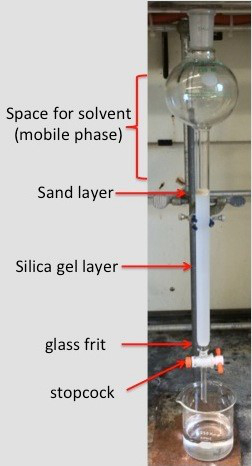柱层析法
Overview
资料来源: 实验室的博士吉米 · 佛朗哥-梅里马克大学
柱层析法是最有用的技术,纯化化合物之一。这种技术利用一个平稳的阶段,装在列和通过列中的流动相。这项技术利用极性化合物,允许轻便分离分子之间的差异。1两个最常见色谱固定相用于柱层析硅胶 (SiO2),氧化铝 (Al2O3),最常见的是用有机溶剂移动阶段。2 solvent(s) 为流动相选择都依赖被纯化分子的极性。通常更多极性化合物需要更多的极性溶剂以便利通道的分子通过固定相。纯化过程完成溶剂可以从使用旋转蒸发仪产生孤立的材料收集馏分中删除。
Procedure
1.硅胶浆
- 硅凝胶倒入锥形瓶。包装材料的重量应该是大约 50 x 被分离的样品。如果被分离的化合物有很相似的Rf值,它可能需要使用更大数额的每个样品,在此示例中是二氧化硅。
- 白炭黑在锥形瓶,因为 50 毫克的样品 (45 毫克的芴酮和四苯基卟啉 5mg) 被隔离的地方 10 克。
- 添加溶剂体系 (正己烷/二氯甲烷,70%: 30%) 到锥形瓶含硅凝胶。添加足够的溶剂,以确保所有的硅胶是很好的溶剂。硅不会解散,但混合物将是明显的视觉时溶剂化。一旦已添加溶剂漩涡锥形瓶,以确保所有的白炭黑是很好的溶剂。
2.柱的制备
- 选择适当大小的列。通常列应填充硅胶浆的一半左右。被净化的较大样本、 较大所需的列。
- 插头用一块玻璃羊毛栏的底部。使用长杆,确保羊毛牢牢嵌入在上方旋塞阀栏的底部。
- 一旦羊毛坚定地到位,在玻璃羊毛适用一层薄薄的沙子。
注:如果列
Results
Application and Summary
References
- Mayo, D. W.; Pike, R. M.; Forbes, D. C., Microscale organic laboratory : with multistep and multiscale syntheses. 5th ed.; J. Wiley & Sons: Hoboken, NJ; p xxi, 681 p (2011).
- Armarego, W. L. F.; Chai, C. L. L., Purification of laboratory chemicals. 5th ed.; Butterworth-Heinemann: Amsterdam; Boston; p xv, 609 p (2003).
- Silverman, R. B.; Holladay, M. W., The organic chemistry of drug design and drug action. Third edition / ed.; Elsevier/AP, Academic Press, is an imprint of Elsevier: Amsterdam ; Boston; p xviii, 517 pages (2014).
- Mortensen, D. S.; Perrin-Ninkovic, S. M.; Shevlin, G.; Elsner, J.; Zhao, J.; Whitefield, B. et. al. Optimization of a Series of Triazole Containing Mammalian Target of Rapamycin (mTOR) Kinase Inhibitors and the Discovery of CC-115. Journal of Medicinal Chemistry (2015).
- Davies, D. R.; Johnson, T. M., Isolation of Three Components from Spearmint Oil: An Exercise in Column and Thin-Layer Chromatography. Journal of Chemical Education,84 (2), 318 (2007).
- Taber, D. F.; Hoerrner, R. S., Column chromatography: Isolation of caffeine. Journal of Chemical Education, 68 (1), 73 (1991).
Tags
跳至...
此集合中的视频:

Now Playing
柱层析法
Organic Chemistry
360.5K Views

催化导论
Organic Chemistry
34.5K Views

程序集的激烈化学反应回流系统
Organic Chemistry
167.8K Views

进行室温下反应
Organic Chemistry
70.7K Views

溅镀转移的溶剂
Organic Chemistry
41.6K Views

随着冻融泵循环脱气液体
Organic Chemistry
56.3K Views

制备无水试剂和设备
Organic Chemistry
79.4K Views

重结晶法净化化合物
Organic Chemistry
709.2K Views

通过沉淀混合物的分离
Organic Chemistry
157.8K Views

固-液萃取
Organic Chemistry
237.9K Views

旋转蒸发来去除溶剂
Organic Chemistry
212.9K Views

分馏
Organic Chemistry
334.6K Views

X 射线衍射分析晶体生长
Organic Chemistry
32.4K Views

Performing 1D Thin Layer Chromatography
Organic Chemistry
289.9K Views

核磁共振 (NMR)
Organic Chemistry
248.3K Views
版权所属 © 2025 MyJoVE 公司版权所有,本公司不涉及任何医疗业务和医疗服务。
